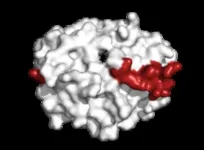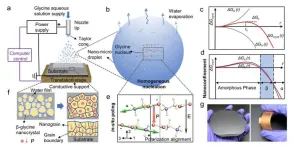(Press-News.org) Québec City, August 10, 2023 - Scientists at Université Laval and the University of Lethbridge have succeeded in reversing certain cognitive manifestations associated with Alzheimer's disease in an animal model of the disease. Their results have been published in the scientific journal Brain.
"Although this has yet to be demonstrated in humans, we believe that the mechanism we have uncovered constitutes a very interesting therapeutic target, because it not only slows down the progression of the disease but also partially restores certain cognitive functions," comments study leader Yves De Koninck, a professor in the Faculty of Medicine and researcher at Université Laval's CERVO research centre.
Previous studies have shown that even before Alzheimer's symptoms appear, brain activity is disrupted in people who go on to develop the disease. "There is neuronal hyperactivity and signal disorganization in the brain. Our hypothesis is that a mechanism that regulates neuronal activity, more specifically the one responsible for inhibiting neuronal signals, is disrupted," explains the researcher.
The main inhibitor of neuronal signals in the human brain is the neurotransmitter GABA. It works in close collaboration with a cotransporter, KCC2. This is an ion pump, located in the cell membrane, which circulates chloride and potassium ions between the inside and outside of neurons," recalls Professor De Koninck. Maintaining this ion pump in the neuron's cell membrane could slow down or reverse the pathology.
"A loss of KCC2 in the cell membrane can lead to neuronal hyperactivity. One study has already shown that KCC2 levels were reduced in the brains of deceased Alzheimer's patients. This gave us the idea of examining the role of KCC2 in an animal model of Alzheimer's disease," adds the researcher.
Promising Results in Mice
To do this, scientists used mouse lines expressing a manifestation of Alzheimer's disease. The researchers found that when these mice reached the age of four months, KCC2 levels decreased in two regions of their brains: the hippocampus and the prefrontal cortex. These two regions are also affected in people suffering from Alzheimer's disease.
In light of these results, the researchers turned to a molecule developed in their laboratory, CLP290, a KCC2 activator that prevents its depletion. In the short term, the administration of this molecule to mice that already had reduced KCC2 levels improved their spatial memory and social behaviour. In the long term, CLP290 protected them against cognitive decline and neuronal hyperactivity.
"Our results do not imply that the loss of KCC2 causes Alzheimer's disease," insists Prof. De Koninck. "On the other hand, it does appear to cause an ionic imbalance leading to neuronal hyperactivity that can lead to neuronal death. This suggests that by preventing the loss of KCC2, we could slow down and perhaps even reverse certain manifestations of the disease."
For various reasons, CLP290 cannot be used in humans. Professor De Koninck's team is searching for other KCC2-activating molecules that would be well tolerated by Alzheimer's sufferers.
"We have developed new molecules which are currently being evaluated in our laboratory. In parallel with this research, we are testing drugs that are used for purposes other than Alzheimer's in humans, in order to assess their effects on KCC2. Repositioning an existing drug would accelerate work on this new therapeutic avenue," emphasizes the researcher.
The other signatories of the study published in Brain are Iason Keramidis, Julien Bourbonnais, Feng Wang, Dominique Isabel, Marie-Eve Paquet, Romain Sansonetti, Annie Barbeau, Lionel Froux and Antoine Godin, from Université Laval, and Brendan McAllister, Edris Rezaei, Phil Degagne, Mojtaba Nazari, Samsoon Inayat, and Majid Mohajerani, from the University of Lethbridge.
-30-
Source:
Public Relations and Protocol
Université Laval
418-656-3355
medias@ulaval.ca
END
A therapeutic target for Alzheimer's disease discovered
2023-08-10
ELSE PRESS RELEASES FROM THIS DATE:
Common cold virus linked to potentially fatal blood clotting disorder
2023-08-10
CHAPEL HILL, N.C. – Platelets, or thrombocytes, are specialized cellular fragments that form blood clots when we get scrapes and traumatic injuries. Viral infections, autoimmune disease, and other conditions can cause platelet levels to drop throughout the body, termed thrombocytopenia.
After a robust clinical and research collaboration, Stephan Moll, MD, and Jacquelyn Baskin-Miller, MD, both in the UNC School of Medicine, have linked adenovirus infection with a rare blood clotting disorder. This is the first time that the common ...
Education program tackles race-based cancer health disparities
2023-08-10
HOUSTON – (Aug. 10, 2023) Rice University chemist Carolyn Nichol has won a competitive Science Education Partnership Award (SEPA) from the National Institutes of Health to address race-based cancer health disparities by increasing underrepresented minority student populations’ engagement and participation in biosciences education.
The 5-year, $1,038,544 award will support Nichol’s Cancer Health Activism Network for Greater Equity (CHANGE) project in bringing together cutting-edge cancer research with insight on race-based healthcare disparities from the social sciences in a series of transformative high school biology lessons aligned with both ...
Font size can 'nudge' customers toward healthier food choices
2023-08-10
PULLMAN, Wash. -- Restaurants can persuade patrons to choose healthier foods by adjusting the font size of numbers attached to nutritional information on menus, according to a study headed by a Washington State University researcher.
Lead researcher Ruiying Cai, an assistant professor in the WSU School of Hospitality Business Management, said U.S. restaurants with more than 20 locations are already required to show the calorie content of food on their menus. By representing these values incongruously — using physically larger numbers on the page when they’re attached to ...
Researchers unlock mystery of cartilage regeneration in lizards
2023-08-10
A team of researchers from the Keck School of Medicine of USC have published the first detailed description of the interplay between two cell types that allow lizards to regenerate their tails. This research, funded by the National Institutes of Health and published on August 10 in Nature Communications, focused on lizards’ unusual ability to rebuild cartilage, which replaces bone as the main structural tissue in regenerated tails after tail loss.
The discovery could provide insight for researchers studying how to rebuild cartilage damaged by osteoarthritis in humans, a degenerative and debilitating disease that affects about 32.5 million adults ...
Space weather and satellite security: Graz University of Technology and University of Graz supply new forecasting service for the ESA's Space Safety Programme
2023-08-10
After a successful test phase, the Satellite Orbit DecAy (SODA) service, which was jointly developed by TU Graz and the University of Graz, officially became part of the ESA’s Space Safety Programme in mid-July. SODA provides accurate forecasts of the effects of solar storms on low Earth orbiting satellites. This makes TU Graz only the third Austrian institution contributing to this ESA programme. Seibersdorf Laboratories, and the University of Graz, through the Kanzelhöhe Observatory and the Institute of Physics, ...
New high-tech microscope using AI successfully detects malaria in returning travelers
2023-08-10
Each year, more than 200 million people fall sick with malaria and more than half a million of these infections lead to death. The World Health Organization recommends parasite-based diagnosis before starting treatment for the disease caused by Plasmodium parasites. There are various diagnostic methods, including conventional light microscopy, rapid diagnostic tests and PCR.
The standard for malaria diagnosis, however, remains manual light microscopy, during which a specialist examines blood films with a microscope to confirm the presence of malaria parasites. ...
HKUST researchers pioneers technique to self-assemble high-performance biomolecular films
2023-08-10
A research team led by The Hong Kong University of Science and Technology (HKUST) has developed a novel technique to self-assemble a thin layer of amino acids with ordered orientation over a large area that demonstrates high piezoelectric strength, making the manufacturing of biocompatible and biodegradable medical microdevices, such as pacemaker and implantable biosensor, in the near future possible.
The generation of bioelectricity from the piezoelectric effect – reversible conversion between mechanical and electrical energies – has physiological significance in living systems. ...
A platform for integrated spectrometers based on solution-processable semiconductors
2023-08-10
Acquiring real-time spectral information in point-of-care diagnosis, internet-of-thing, and other lab-on-chip applications require spectrometers with hetero-integration capability and miniaturized feature. Compared to conventional semiconductors integrated by heteroepitaxy, solution-processable semiconductors provide a much-flexible integration platform due to their solution-processability, and, therefore, more suitable for the multi-material integrated system. However, solution-processable semiconductors are usually incompatible with the micro-fabrication processes, making them far from practical use in various lab-on-chip applications.
In a new paper published ...
Researchers develop novel technology to quantify protein critical to blood clot formation through breath gas analysis
2023-08-10
Immunothrombosis, or the formation of microscopic blood clots during inflammation, is a major cause of morbidity among patients with sepsis or severe COVID-19. A key enzyme in this process is thrombin. To date, no method exists for early detection of immunothrombosis in a living organism.
A team of investigators led by Ali Hafezi-Moghadam, MD, PhD, director of the Molecular Biomarkers Nano-Imaging Laboratory (MBNI) at Brigham and Women’s Hospital, a founding member of Mass General Brigham healthcare system, and an associate professor of Radiology at Harvard Medical School, developed a novel technology to diagnose immunothrombosis by measuring ...
C-Path welcomes Sanofi to its Type 1 Diabetes Consortium to help advance drug development
2023-08-10
TUCSON, Ariz., August 9, 2023 — Critical Path Institute (C-Path) announced today that Sanofi, a global leader in immunology and diabetes care, has joined its Type 1 Diabetes Consortium (T1DC). Sanofi joins T1DC as part of its commitment to push the boundaries of innovation to improve the lives of those with diabetes.
T1DC was established in 2017 with the goal to significantly advance the drug development landscape for T1D prevention and treatment. The consortium achieves this by fostering ...





